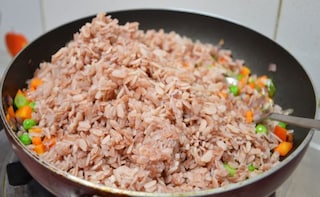Image credit: www.grammarsofcooking.blogspot.in
How to Use Red PohaRed poha is slightly coarser in texture as compared to white poha. It does require a little getting used to, but once you do, you are bound to include it in your regular diet. It is really about making a healthier choice.Red poha can be used pretty much the same way as white poha. You need to wash the poha and soak it in water first, for at least 20 minutes, so that it softens, and then stir fry it with other vegetables and spices. Most recipes in the North call for onions, tomatoes and potatoes, along with fresh coriander leaves to garnish. Whereas in the West and South, you will find the use of peas, curry leaves and lots of peanuts. You can also use your favourite mix of vegetables such as French beans, carrots, cauliflower, etc.
How to Use Red PohaRed poha is slightly coarser in texture as compared to white poha. It does require a little getting used to, but once you do, you are bound to include it in your regular diet. It is really about making a healthier choice.Red poha can be used pretty much the same way as white poha. You need to wash the poha and soak it in water first, for at least 20 minutes, so that it softens, and then stir fry it with other vegetables and spices. Most recipes in the North call for onions, tomatoes and potatoes, along with fresh coriander leaves to garnish. Whereas in the West and South, you will find the use of peas, curry leaves and lots of peanuts. You can also use your favourite mix of vegetables such as French beans, carrots, cauliflower, etc.
Advertisement
Advertisement
For the latest food news, health tips and recipes, like us on Facebook or follow us on Twitter and YouTube.
Advertisement
